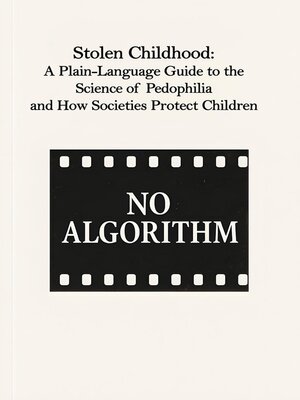Stolen Childhood
ebook ∣ A Plain-Language Guide to the Science of Pedophilia—and How Societies Protect Children
By No Algorithm

Sign up to save your library
With an OverDrive account, you can save your favorite libraries for at-a-glance information about availability. Find out more about OverDrive accounts.
Find this title in Libby, the library reading app by OverDrive.



Search for a digital library with this title
Title found at these libraries:
| Library Name | Distance |
|---|---|
| Loading... |
Introduction: Why This Topic—and Why Now
Child sexual abuse (CSA) is a profound betrayal, an extreme violation of the
safety and trust that every child deserves. Its consequences are not fleeting;
they can ripple through a survivor's life for decades, affecting their
education, relationships, career, and both mental and physical health. It is a
silent epidemic that thrives in secrecy and misunderstanding. The public
conversation about pedophilia, a key driver of some but not all CSA, is often
a volatile mix of fear, deeply ingrained myths, and justifiable anger. While
these emotions are understandable, they can obscure the path to effective
solutions.
This book approaches the topic through a public-health lens. Just as we
study diseases to prevent their spread, we can study the dynamics of CSA to
prevent it from happening. This perspective demands several things: clear
definitions to ensure we are all talking about the same thing; a careful
separation between sexual interest and criminal behavior, which is crucial
for effective prevention; and a firm reliance on evidence-based strategies for
prevention and protection.
The writing style throughout is deliberately plain and direct. The goal is to
make complex scientific and psychological ideas accessible to nonspecialists—parents, teachers, coaches, community leaders, and concerned
citizens—without sacrificing scientific accuracy or compassion. We do not
reproduce graphic or sensational material. The focus is on understanding,
promoting safety, and upholding accountability.
Two core principles guide every page of this book:
1. Protecting children is the absolute, non-negotiable priority. Every
concept, strategy, and piece of data is presented with this ultimate goal
in mind. The well-being and dignity of children are paramount.
2. Prevention works best when the problem is described precisely. We
need to be clear about where the science is certain, where it is still
learning, and where ethics and law must provide firm guidance. To
achieve this, we draw on major, authoritative reference works like the
Diagnostic and Statistical Manual of Mental Disorders (DSM-5-TR)
and the International Classification of Diseases (ICD-11). We also
rely on public-health data from organizations like the Centers for
Disease Control and Prevention (CDC) and the World Health
Organization (WHO), and we synthesize findings from decades of
peer-reviewed research in psychology, psychotherapy, psychiatry,
criminology, and child protection.
We distinguish among a person's internal sexual interest, their risk of
causing harm, and their criminal actions because this clarity is what supports
better policies, smarter safeguards, and more effective interventions.
Understanding the problem accurately is the first and most critical step
toward solving it.







